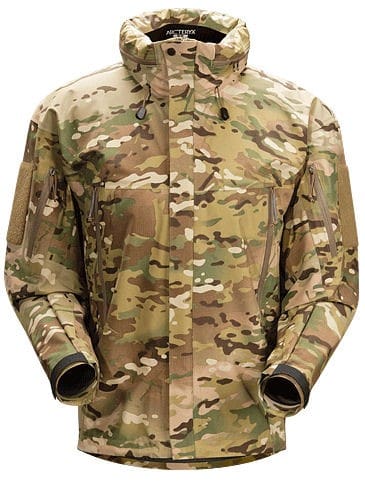Currently consisting of the Alpha Jacket, Alpha Parka, Alpha Pant, Gryphon Halfshell and Gryphon Pant, the Hide/Dry series from Arc’teryx LEAF relies on GORE-TEX fabric printed in the popular MultiCam fabric.
Arc’teryx combines the Gore fabric with WaterTight zippers and Dry Cuffs to as well as other construction techniques to keep you warm and dry.



Farewell, flapped pockets, you served us for long time, until that crazy marketing people decided to invert the zippers and to say it’s watertight…
They aren’t just inverted zippers. They are waterproof zippers.
It was just ironic figure of speech.
I’m aware of actual difference between inverted and inverted+laminated zippers called “watertight”. All that mess with such a “modern thing” works for only one thing: to simplify production and to legally limit the life cycle of product. After a couple of years of intensive regular use, lamination will be peeled off and it will be just inverted zipper.
I saw it on genuine outerwear made by top brands (to be honest – not on the Arc’teryx) using YKK zippers. Do you think it’s enough to consider a tendency?
Makers do know it, and that’s why they use it mainly for pockets, while main zipper usually equipped with flap (because it’s the most intensively used zipper). There are only three types of outerwear with watertight main zipper: fashion outerwear, ultra-light jackets and some special things like kayaking dry-suits (people use it tens of times per year).
Bushman, you’re missing the point. Arc’teryx developed the WaterTight Zip in 1998 first of all to improve easy access to pockets, pit zips AND main zippers. And secondly to minimize the extra weight of the flaps. Arc’teryx will replace the zip free of charge if the life span of the zip is shorter than the jacket itself.
Oh, great.
I don’t really care, who developed it. My statement is: it’s practically bad thing.
“Extra weight”, you said? Let’s calculate.
Mid-weight coated Cordura 420D weights 4 oz. per sq yd. (let’s take such a tough fabric – it’s heavier than every fabric you could see on jacket). It’s 135.6 grams per sq meter. I measured six flaps on my jacket: 20×7 cm, 20×5 cm, 15×5 cm (two of each type, two patches of fabric per each flap). It’s 1260 sq cm = 0.126 sq meter.
It means, all that flaps together weights 17 grams only or 0.5 oz. Can you feel it on your jacket? It’s less than 1/3 of Snickers bar. “Minimize weight”? Ridiculous.
Free replacement, you said?
It means, that maker offers some “reduced reliability product”, keeping in mind, that most of people will not use it intensively, so it’s cheaper for maker to produce it that way and replace it for free for some few people, who really use it. I don’t want the replacement (messing with postal service, waiting etc), I need simple details that kept things reliable for years. But simple flaps became more and more rare features even on expensive jackets.
Excuse me, I forgot about “easy access”.
Do you feel the flaps are some real obstacles to get your hand into the pocket? I’m not. And most of people (who are not disabled) should not, I believe. Pockets are made to keep things secure from falling out and from elements, not for putting your hands there every second. So let’s keep it working like that. If I’ll be disabled, I’ll maybe think about jacket with no flaps, but not now.
Just a question: have you ever owned an Arc’teryx jacket and used it for the purpose it was build for?
I am wondering if your assumptions on reduced reliability are based on facts and experience or on stomach feeling and your personal common sense? You’re stating that the Arc’teryx customers like professional mountain guides, alpinists, mountain rescue services and military and law enforcement professionals from around the world are not using their jackets enough to test the quality? And yes, these people do seem to care about weight saving and easy access to pockets without being disabled.
If you’ve read my comments above, you should know, that I already honestly said, that my experience covers YKK zippers, not Arc’teryx. But the construction and materials are quite similar in both cases. And it gives me the idea, that there is nothing so special with Arc’teryx zippers compared to other respected brands. Your disrespectful words about my experience could be reasonable (it’s Internet, so we all can be pretenders or even kids), but I could say, that I’m, at least, living in such a climate, where you have to use such stuff to stay active outdoor for half of the year. Much worse than in Denmark, where you are reselling the Arc’teryx gear. And I do know what means to be off the grid for weeks, in forests, mountains and tundra.
I’m sure, that professionals you’ve mentioned do use their gear intensively. But I believe that professionals could rely on the same idea you’ve mentioned first: “if it will brake, I’ll just send it back”. (Thing that I don’t want to do just because I know, that things could be better in the way they did before.)
All that is just the result of modern production/sales politics, not lack of experience, professionalism or something.
And again, saving 0.5 oz makes insensible profit for end user, but saving 1 sq yard per ten jackets makes some visible economy for maker. So who really needs that economy?
Anyway, I understand your point, but I can’t agree. So, let’s play market: when I’ll need a new jacket next time, I’ll give my money to Arktis (UK) or Bergans (NO) for some classic stuff, when you’ll need a new jacket – you’ll give it to Arc’teryx. Everybody will be happy then.
The lady doth protest too much, methinks.
It’s a freaking zipper…